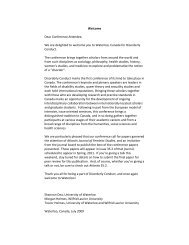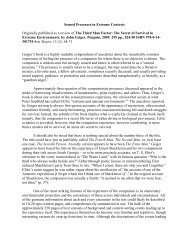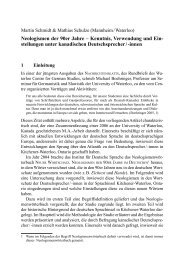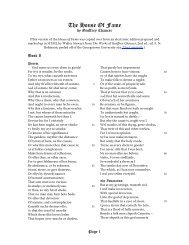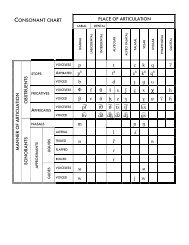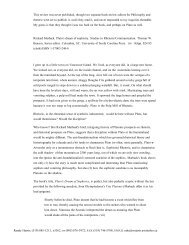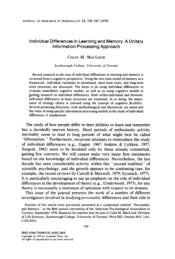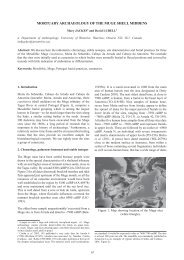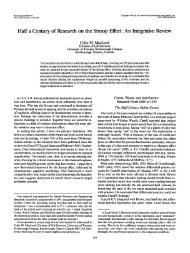The mid seventeenth century collapse of Iroquoian Ontario:
The mid seventeenth century collapse of Iroquoian Ontario:
The mid seventeenth century collapse of Iroquoian Ontario:
You also want an ePaper? Increase the reach of your titles
YUMPU automatically turns print PDFs into web optimized ePapers that Google loves.
the Mid Seventeenth centuRy collapSe <strong>of</strong> iRoquoian on ta R i o<br />
Between November and March 1640-1641, two Jesuit fathers, Jean de Brébeuf and Pierre<br />
Joseph Marie Chaumonot, travelled from Huronia and passed through eighteen Neutral<br />
Nation settlements. <strong>The</strong>y stayed in ten villages in which they estimated there were about<br />
500 fires (two families shared each <strong>of</strong> the several hearths which were located along the centre<br />
<strong>of</strong> a longhouse) and 3 000 people. <strong>The</strong> Jesuits noted that there had been three years <strong>of</strong> “unusually<br />
prevalent” war, famine and sickness, but that there were still about 12 000 people and<br />
4 000 warriors in about 40 villages and hamlets (JR, 20, p. 95, 105; 21, p. 189, 191, 223).<br />
It is unfortunate that letters written by the two Jesuit fathers while among the Neutral<br />
were lost en route to Huronia. Chaumonot’s autobiography (2002) does not contain much<br />
detail on his visit to the Neutral, and Brébeuf was killed by the Iroquois in 1649, so written<br />
records <strong>of</strong> the Neutral are limited.<br />
<strong>The</strong> demography <strong>of</strong> the Grimsby cemetery<br />
Beads, especially European trade beads, provide a date for the Grimsby cemetery: Fox and<br />
Kenyon (1986) suggest that the cemetery spans at least 30 years. Three phases are distinguished<br />
(II, IIIa and IIIb), each lasting about 10 years and – as will become evident – the<br />
terminal date must be 1651. Sempowski et al. (2001, p. 513) suggest that trade beads were not<br />
personal possessions which were retained, but rather goods that were used specifically as<br />
mortuary items. Thus, trade bead variations provide relative dates for sites because they were<br />
not retained and circulated over long periods <strong>of</strong> time. <strong>The</strong> variations can relate to details <strong>of</strong><br />
manufacture. <strong>The</strong> royal blue glass trade beads from Grimsby have been confirmed as <strong>of</strong> the<br />
same date as similar beads from Ossossané, for which the date (1636 or later) is known (Kidd,<br />
1953); the chemical composition <strong>of</strong> some subsets <strong>of</strong> beads from the two sites is identical<br />
(Hancock et al., 2000). However, trade bead variations relating to specific details <strong>of</strong> design and<br />
colour are the determinants <strong>of</strong> the phases. Kenyon (1986) summarizes the situation by noting<br />
that phase II on Neutral sites is dominated by white beads with a few blue and black examples<br />
occurring and red virtually unrepresented. In phase III, however, the situation is reversed:<br />
over 60% <strong>of</strong> beads are red, though there are some blue, and no more than a few are white. It<br />
is possible that this shift in trade beads, from dominant white to dominant red took place in<br />
Huronia somewhere around 1620. By 1630, red beads were common, and in the Grimsby<br />
cemetery they jump from none in phase II to close to 90-100% in some phase III graves.<br />
Not all burials had sufficient numbers <strong>of</strong> beads to be evaluated and Kenyon and Fox<br />
(1986) analyzed the beads in only 19 features. However, Fox (in litt. 21/01/1983) suggested<br />
the total number <strong>of</strong> features (mostly burial pits) recognized as definitely or possibly belonging<br />
to the three bead phases are as follows: six features might be ascribed to phase II,<br />
11 features to phase IIIa and 14 features to phase IIIb. In general terms, the graves <strong>of</strong> each<br />
phase clustered in separate areas <strong>of</strong> the cemetery, phase II forming a node in the south west<br />
and the phase IIIa and IIIb features fanning out to the east and north east (fig. 3).<br />
<strong>The</strong> cemetery may reflect a special set <strong>of</strong> circumstances. No associated village has been<br />
found and the size and time depth <strong>of</strong> the cemetery are unique among known Neutral sites.<br />
Lennox and Fitzgerald (1990, p. 414), in noting the trade bead phases associated with Neutral<br />
353



